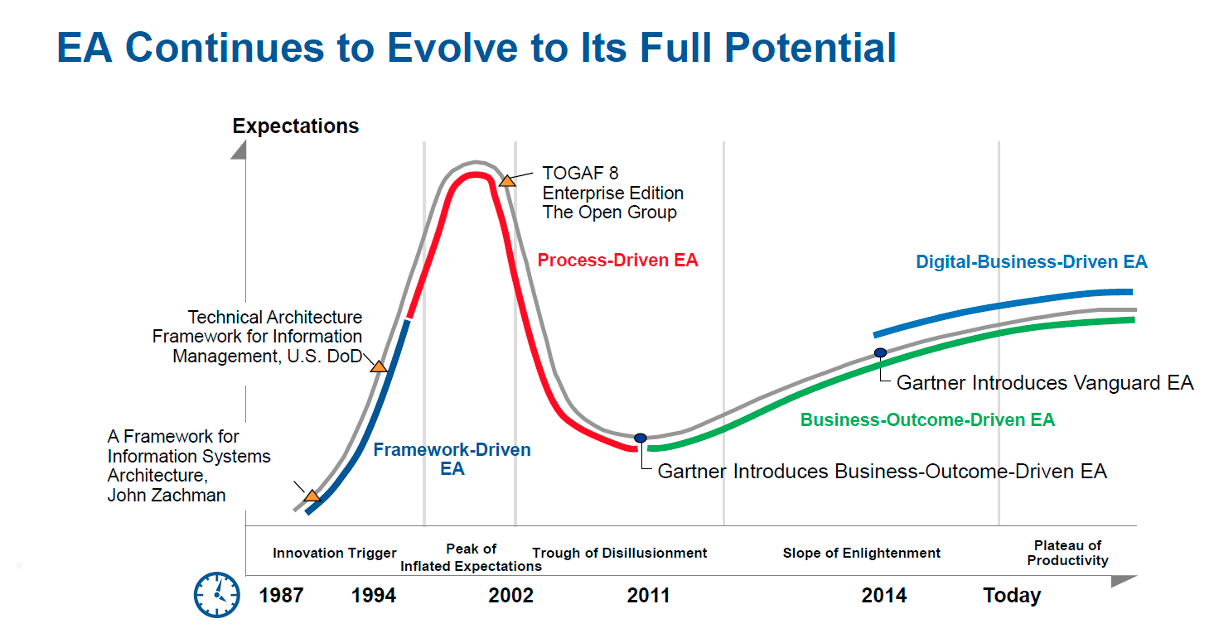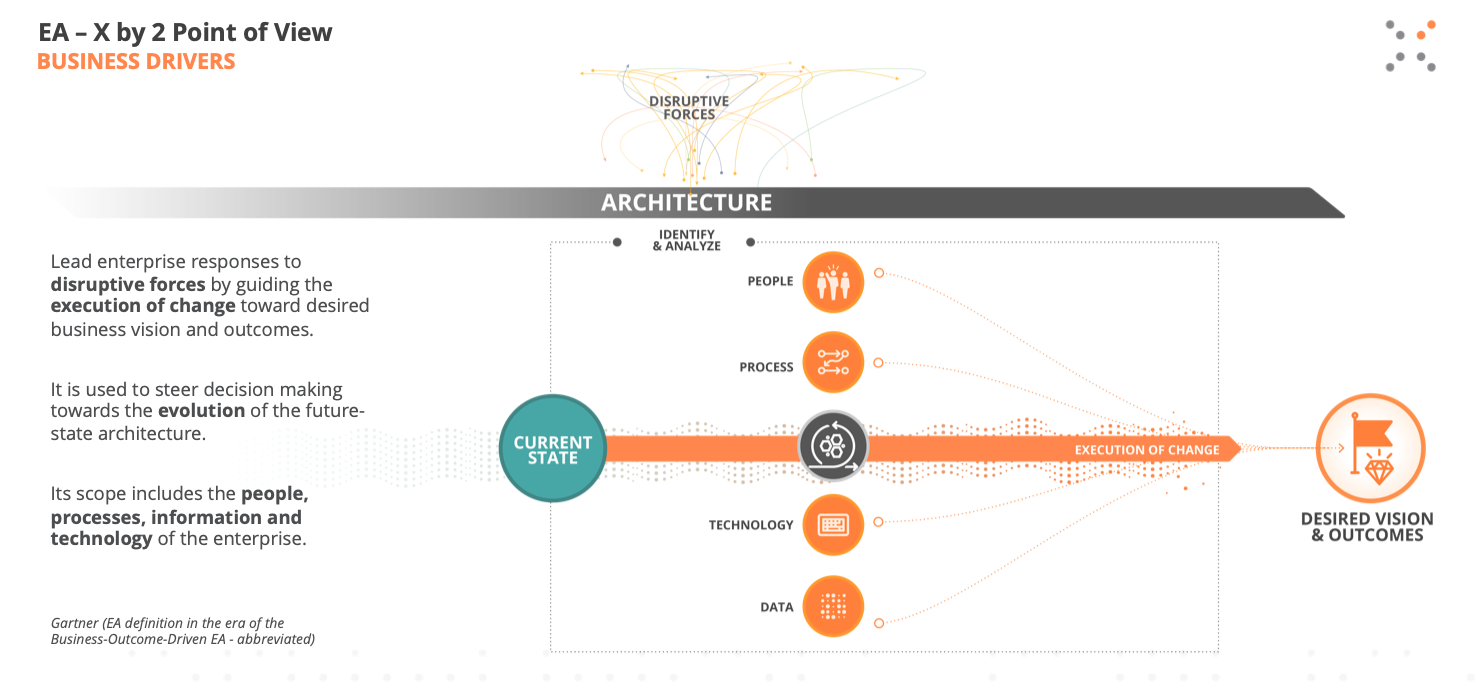
Road to Success Paved with Business-Driven Architecture
The road to competitive advantage and market success in the healthcare and insurance industry has taken many twists and turns since the advent of the computerized age. From mainframes to client-server to the modern Web, from Fortran to COBOL to Java, and from distributed networking to Agile, technological innovations and methodologies have come and gone. Some technologies were more effective than others, and some have lasted much longer than others, for better and sometimes worse. The idea and promise of enterprise architecture as a way to think holistically about organizations and their processes is one of the survivors, although it too has had its ups and downs. Its scope and use in organizations have evolved over the decades, as has its proponents and practitioners understanding of the benefits a well-structured and cohesive architectural approach can bring to an organization.
Defining and understanding EA has always been difficult. The EA evolution is a story about the inherent dichotomy of a static view of the point-in-time enterprise “world,” with neatly classified artifacts representing its various assets and the dynamic nature of the business, all while constant change is occurring and artifacts are often obsolete before they can be fully completed. Given this dichotomy, as EA evolved practitioners learned what did and did not work, and their experience helped to shed light on the things that were impractical, thus sharpening the focus on real enterprise value through EA.
The first iteration of the EA concept was introduced in 1987 by John Zachman, in his article A Framework for Information Systems Architecture. Since then, there have been several iterations of EA evolution, all of which have moved the ideas and practices of EA closer to the core business interests of any organization. At a high level, the major iterations of EA can be broadly identified by what the driving focus was at any given point in time. Over the past thirty-two years, the order of that focus has been: Framework-Driven EA; Process-Driven EA; Business-Outcome-Driven EA; and Digital-Business-Driven EA, illustrated as follows in the form and format of Gartner’s famous hype-cycle curve:

The maturing of the EA concept over the years has led it to where it is today: focused squarely on producing positive outcomes for the business of any organization. And while it took some time to arrive, there can be no doubt that the mission of an EA practice in today’s world is to partner with business and IT leaders to create and implement effective strategies across people, process and technology dimensions that deal with the disruptive forces facing the organization:

As illustrated, an enterprise architecture based on business-driven outcomes acts as a first frontier for responding to external forces, and for making internal IT decisions in a manner that is consistent with the business vision of the enterprise. For example, external disruptive forces like sudden market shifts due to new competitors, regulatory changes that impact processes, or new technologies, can be better absorbed by the enterprise with a repeatable and effective EA approach in place. Such a business-outcome driven EA approach enables the enterprise to:
- Contextualize enterprise responses to disruptive forces by guiding the execution of change toward desired business visions and outcomes. This prevents knee-jerk type reactions to disruption.
- Steer decision making towards the evolution of the future state architecture.
- Mobilize the depth and breadth of the enterprise, including its people, processes, information, and technologies.
EA plays a crucial role in any enterprise’s efforts to be well organized, and to have consistent long and short-term strategies to respond to the rapidly changing world. But the real goal is not just creating the strategies, but the actual change those strategies are supposed to affect. And admittedly, change in most any complex enterprise environment is no easy feat.To position themselves better to absorb change, many organizations are adopting an Agile methodological approach and applying it to various facets of the enterprise. Software development is often the most discussed facet to be sure, but an Agile approach can and is also be used in areas like product development, customer service, and quality control. That said, it is very important to understand the synergies between business-outcome driven EA and Agile as follows:
- Future-state transitions must be agile-friendly
EA must think about agile execution while designing the roadmaps - Focusing on enabling system agility in the enterprise
Any change is difficult if the underlying systems architecture is tightly coupled and fragile, but there must be an ongoing effort to improve it - Guiding execution of the architecture activities themselves
When it comes to architecture organization and governance, Agile principles should be consistently applied
Focusing on business outcomes and deep connections between Enterprise Architecture and Agile is at the heart of any visionary organization’s business and process philosophies and methodologies. Doing so directly impacts work in Architecture Governance, Solution Architecture, Information Architecture, and the like, and places the use of people, process, information, and technology at the wheel of driving positive business outcomes. Done well, it’s also an approach that accurately represents an enterprises’ culture, history, maturity and other defining characteristics
One of the keys to long term enterprise stability and success is creating an architectural approach that is business centered and business driven. It takes some time to accomplish, but the payoff is nothing less than the ability to survive and thrive in disruptive times. That seems worth it.
Related Articles
-
The fear some clients have around moving to the cloud is often based on a misunderstanding of what cloud services have to offer.
Read More -
In just a few short years, information technology has gone from tactical, to strategic, to existential in nature.
Read More -
Core systems modernization, Cloud and Mobility strategies, and investments in Insurtech startups are just a few of the ways insurers are re-positioning.
Read More



